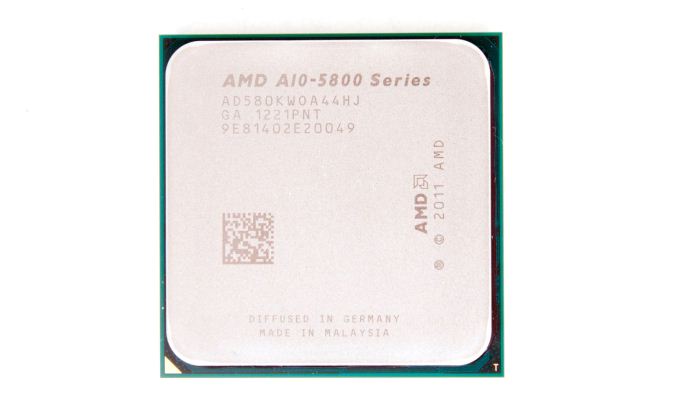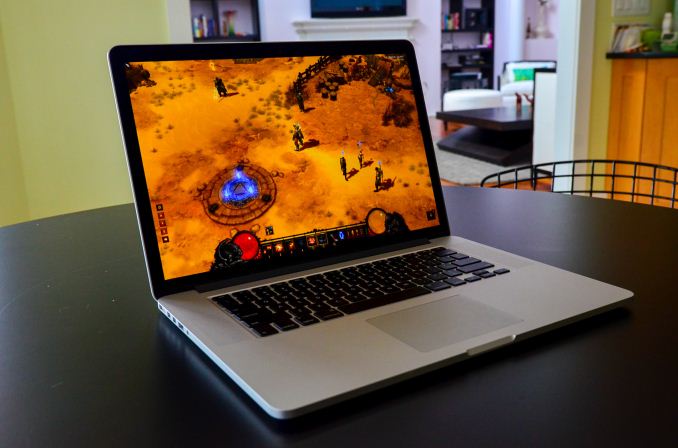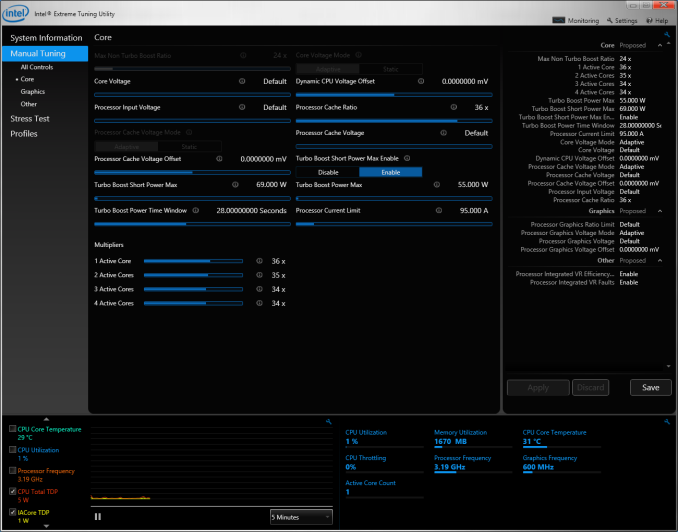Intel Iris Pro 5200 Graphics Review: Core i7-4950HQ Tested
by Anand Lal Shimpi on June 1, 2013 10:01 AM ESTThe Comparison Points
Intel sort of dropped this CRB off without anything to compare it to, so I scrambled over the past week looking for things to put Iris Pro’s performance in perspective. The obvious candidate was Apple’s 15-inch MacBook Pro with Retina Display. I expect its successor will use Iris Pro 5200, making this a perfect comparison point. The 15-inch rMBP is equipped with a GeForce GT 650M with a 900MHz core clock and a 5GHz memory datarate.
I also dusted off a GeForce GT 640 desktop card to shed a little more light on the 650M comparison. The 640 has a slightly higher core clock (925MHz) but it only has 1.7GHz DDR3, working out to be 27GB/s of memory bandwidth compared to 83GB/s for the 650M. Seeing how Iris Pro compares to the GT 640 and 650M will tell us just how good of a job Crystalwell is doing.
Next up is the desktop Core i7-4770K with HD 4600 graphics. This is a Haswell GT2 implementation, but at a much higher TDP than the 47W mobile part we’re comparing it to (84W). In a notebook you can expect a much bigger gap in performance between the HD 4600 and Iris Pro than what we’re showing here. Similarly I also included a 77W HD 4000 for a comparison to Ivy Bridge graphics.
On the AMD front I have the 35W A10-4600M (codename Trinity), featuring AMD’s 7660G processor graphics. I also included the 100W A10-5800 as a reference point since we were largely pleased with the GPU performance of Trinity on the desktop.
I listed TDPs with all of the parts I’m comparing here. In the case of the GT 640 I’m adding the TDP of the CPU (84W) and the GPU (65W). TDP is half of the story with Iris Pro, because the CPU, GPU and eDRAM all fit into the same 47W power envelope. With a discrete GPU, like the 650M, you end up with an extra 45W on top of the CPU’s TDP. In reality the host CPU won’t be running at anywhere near its 45W max in that case, so the power savings are likely not as great as you’d expect but they’ll still be present.
At the request of at least one very eager OEM, Intel is offering a higher-TDP configuration of the i7-4950HQ. Using Intel’s Extreme Tuning Utility (XTU) I was able to simulate this cTDP up configuration by increasing the sustained power limit to 55W, and moving the short term turbo power limit up to 69W. OEMs moving from a 2-chip CPU + GPU solution down to a single Iris Pro are encouraged to do the same as their existing thermal solutions should be more than adequate to cool a 55W part. I strongly suspect this is the configuration we’ll see in the next-generation 15-inch MacBook Pro with Retina Display.
To remove as many bottlenecks as possible I configured all integrated GPU options (other than Iris Pro 5200) with the fastest supported memory. That worked out to being DDR3-2133 on desktop Trinity and desktop IVB, and DDR3-2400 on desktop Haswell (HD 4600). The mobile platforms, including Iris Pro 5200, all used DDR3-1600.
On the software side I used NVIDIA's GeForce R320 v320.18, AMD's Catalyst 13.6 beta and Intel's 9.18.10.3177 drivers with Crystalwell support.













177 Comments
View All Comments
DanaGoyette - Saturday, June 1, 2013 - link
Any idea if this IGP supports 30-bit color and/or 120Hz displays?Currently, laptops like the HP EliteBook 8770w and Dell Precision M6700 haven't been able to use Optimus if you opt for such displays. It would be nice to see that question addressed...
DickGumshoe - Saturday, June 1, 2013 - link
I have been planning on getting a Haswell rMBP 15". I was holding out for Haswell namely due to the increased iGPU performance. My primary issue with the current Ivy Bridge rMBP is the lagginess with much of the UI, especially when there are multiple open windows.However, I'm a bit concerned about how the Haswell CPU's will compare with the current Ivy Bridge CPU's that Apple is currently shipping with the rMBP. The Haswell equivalent of the current rMBP Ivy Bridge CPU's do not have the Iris Pro, they only have the "slightly improved" HD 4600.
Obviously, we still need to wait until WWDC, but based on the released Haswell info, will Haswell only be a slight bump in performance for the 15" rMBP? If so, that is *very* disappointing news.
hfm - Saturday, June 1, 2013 - link
This is a huge win for Intel, definitely performance on par with a 650M. It's just as playable on nearly all those games at 1366x768. Even though the 650M pulls away at 1600X900, I wouldn't call either gpu playable in most of those games at that resolution.you look at it intelligently, this is a huge win by Intel. The 750M may save them, but if I was in the market for an Ultrabook to complement my gaming notebook, I would definitely go with iris pro. Hell, even if I didn't have a dedicated gaming notebook I would probably get iris Peru in my Ultrabook just for the power savings, it's not that much slower at playable resolution.
IntelUser2000 - Tuesday, June 4, 2013 - link
Iris Pro 5200 with eDRAM is only for the quad core standard notebook parts. The highest available for the Ultrabook is the 28W version, the regular Iris 5100. Preliminary results shows the Iris 5100 to be roughly on par with Desktop HD 4600.smilingcrow - Saturday, June 1, 2013 - link
For those commenting about pricing Intel has only released data for the high end Iris Pro enabled SKUs at this point and cheaper ones are due later.The high end chips are generally best avoided due to being poor value so stay tuned.
whyso - Saturday, June 1, 2013 - link
Yes, the rmbp is clearly using 90 watts on an 85 watt power adapter for the WHOLE SYSTEM!gxtoast - Sunday, June 2, 2013 - link
Question for Anand:I'm looking at getting a Haswell 15" Ultrabook with 16GB RAM and plenty of SSD to run up come fairly sophisticated Cisco, Microsoft and VMware cloud labs.
Is it likely that the Crystalwell cache could offset the lower performance specifications on the 4950HQ to make it as competitive, or more so, against the 4900MQ in this scenario?
It would also be good to understand the performance improvement, for non-game video tasks, the HQ part might have over the 4900MQ on a FHD panel. If the advantage isn't there, then, unless the Crystalwell makes a big difference, the 4900MQ part is likely the one to get.
Cheers
piesquared - Sunday, June 2, 2013 - link
Question. Why in Kabini reviews did we get the standard "just wait til intel releases their next gen parts to see the real competion OMGBBSAUCE!!" marketing spiel, while not a mention that hsw's competition is Kaveri?IntelUser2000 - Sunday, June 2, 2013 - link
Uhh, because Haswell launch was less than a month away from Kabini, while Kaveri is 6+ months away from Haswell?AMD paper launched Kabini and Richland in March, and products are coming now. Kaveri claims to be late Q4 for Desktop and early Q1 next year for mobile. If they do the same thing, that means Feb-March for Desktop Kaveri and April/May for Mobile. Yeah.... perhaps you should think about that.
JarredWalton - Sunday, June 2, 2013 - link
The Kabini article never said, "just wait and see what Intel has coming!" so much as it said, "We need to see the actual notebooks to see how this plays out, and with Intel's Celeron and Pentium ULV parts are already at Kabini's expected price point, it's a tough row to hoe." Kabini is great as an ARM or Atom competitor; it's not quite so awesome compared to Core i3, unless the OEMs pass the price savings along in some meaningful way. I'd take Kabini with a better display over Core i3 ULV, but I'll be shocked if we actually see a major OEM do Kabini with a quality 1080p panel for under $500.